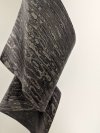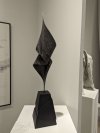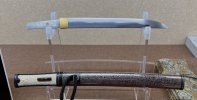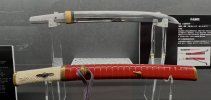You are using an out of date browser. It may not display this or other websites correctly.
You should upgrade or use an alternative browser.
You should upgrade or use an alternative browser.
More Japanese Eye Candy
- Thread starter NihontoEd
- Start date
- Joined
- Aug 4, 2023
- Messages
- 154
Was there any info on how the mokume saya was made and constructed?A few more high end swords. Notice the Mokume Gane saya on the top koshirae, quite lovely to my eye.
View attachment 2412991
View attachment 2412989
View attachment 2412988
I would love to give making a mokume gane saya a try.
RHINOKNIVES
Gold Member
- Joined
- May 6, 2000
- Messages
- 4,711
I have not made Mokume, I have used it, Brass, Copper & Silver heated & hammered . Try Google . I’m sure there are a few techniques…just like making Damascus…Have fun & stay safe.
- Joined
- Aug 4, 2023
- Messages
- 154
sorry was talking about how the sheath/scabbard was constructed not so much the Mokume GaneI have not made Mokume, I have used it, Brass, Copper & Silver heated & hammered . Try Google . I’m sure there are a few techniques…just like making Damascus…Have fun & stay safe.
I'm not familiar with what to search for as to find the best results.
when searching sometimes requires the name of the technique "for example repousse"
if I had to guess how it might have been done I would say mokume was forged into an oversized round bar then placed on a lathe to drill out an undersized hole all the way through the tube then drifted to get a taper in the core for a wood core to house the blade and the respective end fitting for the saya made and added from there.
or the mokume was hammered into sheets and wraped and welded around a wood core perhaps by wraping then cutting the sheet to overlap just enough to weld by hammering over likely a task specific anvil seems then blended by sanding the seems down and the wood core added and again the other fittings
these were the two ways that came to mind but would really like to know how they did it.
RHINOKNIVES
Gold Member
- Joined
- May 6, 2000
- Messages
- 4,711
There seems to be a cut line down the entire Saya. Forged into shape, then sandwiched cut & hollowed out? There also is a newer material that looks like mokume, but is a synthetic.i used it for handles a few times. I cant remember the name. I had to stop making do to development of Asthma about a decade ago. I tend to believe it’s that due to the weight it would be of a full metal Saya & the sandwich cut line, It’s made or at least I purchased it from a supplier in the USA. If the name/supplier comes to minds. I’ll PM you the information.sorry was talking about how the sheath/scabbard was constructed not so much the Mokume Gane
I'm not familiar with what to search for as to find the best results.
when searching sometimes requires the name of the technique "for example repousse"
if I had to guess how it might have been done I would say mokume was forged into an oversized round bar then placed on a lathe to drill out an undersized hole all the way through the tube then drifted to get a taper in the core for a wood core to house the blade and the respective end fitting for the saya made and added from there.
or the mokume was hammered into sheets and wraped and welded around a wood core perhaps by wraping then cutting the sheet to overlap just enough to weld by hammering over likely a task specific anvil seems then blended by sanding the seems down and the wood core added and again the other fittings
these were the two ways that came to mind but would really like to know how they did it.
- Joined
- Aug 4, 2023
- Messages
- 154
awesome info thanks.There seems to be a cut line down the entire Saya. Forged into shape, then sandwiched cut & hollowed out? There also is a newer material that looks like mokume, but is a synthetic.i used it for handles a few times. I cant remember the name. I had to stop making do to development of Asthma about a decade ago. I tend to believe it’s that due to the weight it would be of a full metal Saya & the sandwich cut line, It’s made or at least I purchased it from a supplier in the USA. If the name/supplier comes to minds. I’ll PM you the information.
NihontoEd
Gold Member
- Joined
- Dec 8, 2011
- Messages
- 646
So many questions. I will try to answer in the order they were posted.
1. I am not sure exactly how the saya was made. If true mokume gane than I suppose it would have been forged, then rolled out into a thin sheet, annealed and shaped. But again, that is merely my guess.
2. Katana are displayed edge up, Tachi edge down. Though occasionally you will see them otherwise.
1. No, there was no information on how the saya was constructed. They are not big on sharing technique.
2. As Rhino said above there are various techniques. My guess is above.
A Tanto saya such as that would only require a pie approximately 5-6" wide. With a rolling mill and equipment available today, easy peasy .
.
Chris Marks taught me how to make it years ago in a coal forge, I'm sure things have improved since then.
* I would be interested in seeing the synthetic mokume as well.
1. I am not sure exactly how the saya was made. If true mokume gane than I suppose it would have been forged, then rolled out into a thin sheet, annealed and shaped. But again, that is merely my guess.
2. Katana are displayed edge up, Tachi edge down. Though occasionally you will see them otherwise.
1. No, there was no information on how the saya was constructed. They are not big on sharing technique.
2. As Rhino said above there are various techniques. My guess is above.
A Tanto saya such as that would only require a pie approximately 5-6" wide. With a rolling mill and equipment available today, easy peasy
Chris Marks taught me how to make it years ago in a coal forge, I'm sure things have improved since then.
* I would be interested in seeing the synthetic mokume as well.
- Joined
- Aug 4, 2023
- Messages
- 154
I know they are not too keen on sharing information like that I at least hope they are keeping note books and work journals because if everything is just passed on to the next generation verbally then much is likely being lost,just thinking about history and different cultures that had verbal traditions only makes me wonder how much has been lost over the past few hundred years alone.
thanks for the reply and info guys
beautiful swords by the way.
thanks for the reply and info guys
beautiful swords by the way.
NihontoEd
Gold Member
- Joined
- Dec 8, 2011
- Messages
- 646
Thanks, glad you liked them. A friend who does antique restoration was living in Japan some years ago and met a tsuba maker through his connections at the NTHK. He ended up showing this tsuba maker some easier and better methods for producing the patina on his tsuba. The man was shocked that he showed him these "secrets". He was so impressed that he made him two tsuba as gifts.
NihontoEd
Gold Member
- Joined
- Dec 8, 2011
- Messages
- 646
Saw something yesterday I thought might be relevant to the question of how the mokume was made. It somewhat verifies my suspicions that that is is made like the mokume/damascus I learned to make, by forging it out. Artist Kosuke Kato makes these artist impression from various materials, the one shown below is iron and nickel. The process he decribes is exactly like any billet of damacus, forged and folded repeatedly, then hammered into a sheet and formed into whatever shape he deires.







